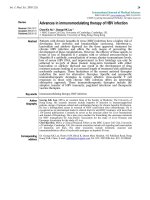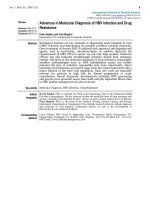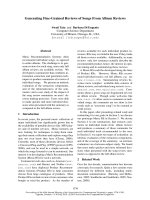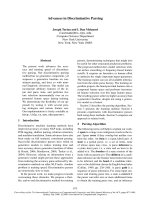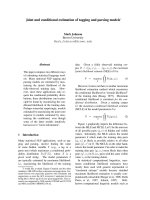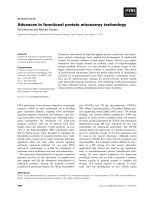Báo cáo khoa học: "Advances in protocolising management of high risk surgical patient" doc
Bạn đang xem bản rút gọn của tài liệu. Xem và tải ngay bản đầy đủ của tài liệu tại đây (33.22 KB, 2 trang )
Page 1 of 2
(page number not for citation purposes)
Available online />Abstract
Despite studies clearly demonstrating significant benefit from
increasing oxygen delivery in the peri-operative period in high risk
surgical patients, the technique has not been widely accepted.
This is due to a variety of reasons, including non-availability of
beds, particularly in the pre-operative period, and the requirement
of inserting a pulmonary artery catheter. There are now data that
suggest that increasing oxygen delivery post-operatively using a
nurse-led protocol based on pulse contour analysis leads to a
major improvement in outcome with reduction in infection rate and
length of hospital stay.
In 1988 Shoemaker and colleagues [1] published a pivotal
and rather complex paper that demonstrated for the first time
that increasing cardiac output and oxygen delivery peri-
operatively in high risk surgical patients led to a dramatic fall
in morbidity and mortality. His group had previously shown
that using simple clinical criteria, patients at high risk of dying
in the post-operative period could be easily identified. He
estimated that as many as 8% to 10% of patients undergoing
major surgery in the USA were in this high risk group, with a
hospital mortality well in excess of 20%
Since these papers were published, numerous studies have
by and large confirmed these original findings. Boyd and
colleagues [2] and Woods and colleagues [3] found that
increasing cardiac output and oxygen delivery pre-operatively
to target values of 4.5 l/min/m
2
and 600 ml/min/m
2
, respectively,
which were maintained into the post-operative period, all led
to a dramatic reduction in both mortality and morbidity. These
studies all used the pulmonary artery catheter for monitoring
cardiac output and a combination of intra-venous fluids and
inotropes to achieve the hemodynamic targets.
Other workers [4-6] have used oesophageal Doppler to
measure cardiac output intra-operatively and achieved maximal
stroke volume using frequent fluid challenges but with
inotropes. Such protocols have consistently led to significant
reductions in post-operative complications and hence hospital
length of stay. Two further studies [8,9] demonstrated that
when such protocols were used solely in the immediate post-
operative period, similar benefits were still obtained.
It should be stressed that these protocols have been used in
a wide variety of patients, ranging from those undergoing
major abdominal and vascular surgery to repair of fractured
neck or femur or major cardiac surgery. Disappointingly,
despite this body of evidence and meta-analyses that clearly
show the overall benefit of this approach, the technique has
not been widely adopted for reasons that are not entirely
clear. These probably include disbelief, ignorance and
logistical difficulties, particularly in regard to intensive care
facilities. In addition, the major debate about the efficacy of
the pulmonary artery catheter has further compounded the
difficulties.
The relative lack of intensive care beds in the UK has in
general made it impossible to admit high risk surgical patients
to the intensive care unit pre-operatively. It has been
estimated that in the UK approximately 40,000 surgical
patients are admitted annually for post-operative intensive
care, with an overall hospital mortality of around 20%. This is
associated with a prolonged length of stay and a very high
complication rate.
It was against this background that the recently published
study by Pearse and colleagues [10] was undertaken. Would
it be feasible to develop a protocol in which identical goals to
those achieved by Shoemaker almost 20 years ago for
cardiac index and oxygen delivery would be sought purely in
the immediate post-operative period? And could these hemo-
dynamic goals be reached and maintained using the relatively
new technology of pulse contour analysis calibrated by
lithium dilution? And, furthermore, if such a protocol did lead
to a significant improvement in outcome, could it then be
implemented on a routine clinical basis in all patients
receiving post-operative care in the intensive care unit at St
George’s Hospital in London? The study did of course show
a dramatic reduction of 12 days in the mean length of stay,
Commentary
Advances in protocolising management of high risk surgical
patients
E David Bennett
St George’s Hospital, Blackshaw Road, London SW17 0QT, UK
Corresponding author: E David Bennett,
Published: 20 February 2006 Critical Care 2006, 10:124 (doi:10.1186/cc4848)
This article is online at />© 2006 BioMed Central Ltd
Page 2 of 2
(page number not for citation purposes)
Critical Care Vol 10 No 1 Bennett
mainly due to a fall in the post-operative infection rate.
Furthermore, about two thirds of the study was carried out by
senior nursing staff, giving encouragement to the notion that
a routine clinical protocol that could be run by the general
intensive care nurses might indeed be developed.
This has now happened and followed a period of detailed
discussion and education. The protocol now in use is largely
based on that used in the study and is run by the nurse
assigned to the care of the patient. Immediately on return
from the operating theatre, the patient is connected to the
Lidco monitor via the radial arterial line and the lithium
calibration procedure completed via the central venous line.
Oxygen delivery is continuously monitored and increased
towards the target value of 600 ml/min/m
2
, initially with
intravenous colloid and then with the addition of dopexamine
at a dose no higher than 1 µg/kg/min. The target value is not
reached in a minority of patients, usually because the heart
rate increases above 100 beats per minute.
It is hoped that about 500 patients annually will be treated
with this protocol and, based on the results obtained in the
study, up to 20 lives will be saved. To the delight of the
hospital managers it is estimated that because of the
projected reduction in hospital stay there should be an annual
cost saving of at least £2,000,000.
It is encouraging to note that at the time of writing the Pearse
and colleagues' study [10] is third in the annual list of most
articles published in Critical Care [11] despite being on this
list for only three months. This does suggest that the intensive
care community is showing real interest, which hopefully will
be translated into routine clinical practice.
Competing interests
The author declares that they have no competing interests.
References
1. Shoemaker WC, Appel PL, Kram HB, Waxman K, Lee TS:
Prospective trial of supranormal values of survivors as thera-
peutic goals in high-risk surgical patients. Chest 1988, 94:
1176-1186.
2. Boyd O, Grounds RM, Bennett ED: A randomized clinical trial of
the effect of deliberate perioperative increase of oxygen
delivery on mortality in high-risk surgical patients. J Am Med
Assoc 1993, 270:2699-2707.
3. Wilson J, Woods I, Fawcett J, Whall R, Dibb W, Morris C,
McManus E: Reducing the risk of major elective surgery: ran-
domized controlled trial of preoperative optimisation of
oxygen delivery. Br Med J 1999, 318:1099-1103.
4. Mythen MG, Webb AR: Perioperative plasma volume expan-
sion reduces the incidence of gut mucosal hypoperfusion
during cardiac surgery. Arch Surg 1995, 130:423-429.
5. Sinclair S, James S, Singer M: Intraoperative intravascular
volume optimisation and length of hospital stay after repair of
proximal femoral fracture: randomised controlled trial. Br Med
J 1997, 315:909-912.
6. Venn R, Steele A, Richardson P, Poloniecki J, Grounds M,
Newman P: Randomized controlled trial to investigate influ-
ence ofthe fluid challenge on duration of hospital stay and
perioperative morbidity in patients with hip fractures. Br J
Anaesth 2002, 88:65-71.
7. Wakeling HG, McFall MR, Jenkins CS, Woods WG, Miles WF,
Barclay GR, Fleming SC: Intraoperative oesophageal Doppler
guided fluid management shortens postoperative hospital
stay after major bowel surgery. Br J Anaesth 2005, 95:634-
642.
8. McKendry M, McGloin H, Saberi D, Caudwell L, Brady AR, Singer
M: Randomised controlled trial assessing the impact of a
nurse delivered, flow monitored protocol for optimisation of
circulatory status after cardiac surgery. Br Med J 2004, 329:
258.
9. Polonen P, Ruokonen E, Hippelainen M, Poyhonen M, Takala J: A
prospective, randomized study of goal-oriented hemody-
namic therapy in cardiac surgical patients. Anesth Analg 2000,
90:1052-1059.
10. Pearse R, Dawson D, Fawcett J, Rhodes A, Grounds M, Bennett
D: Early goal-directed therapy after major surgery reduces
complications and duration of hospital stay. A randomised,
controlled trial. Critical Care 2005, 9:R687-R693.
11. Critical Care top twenty most accessed articles of the past
year [ />
